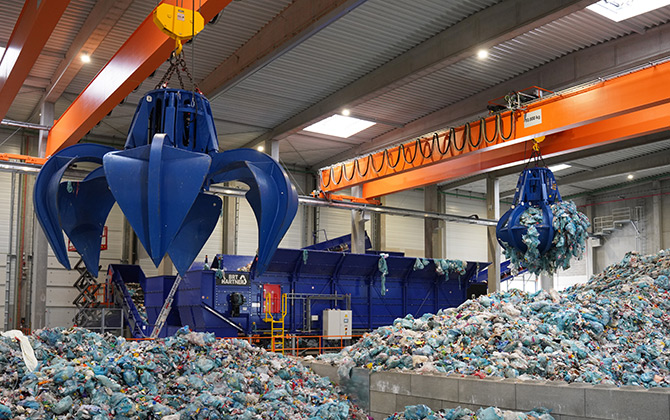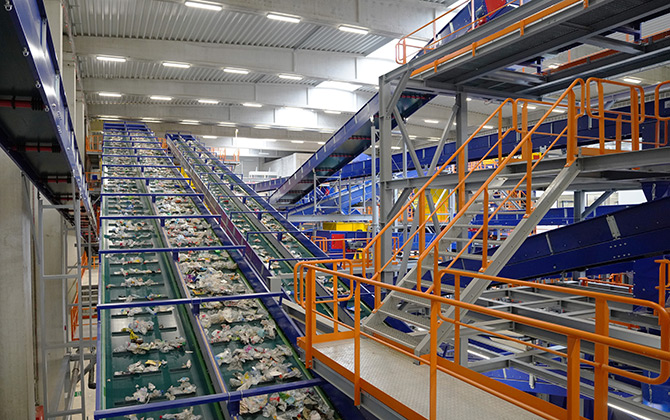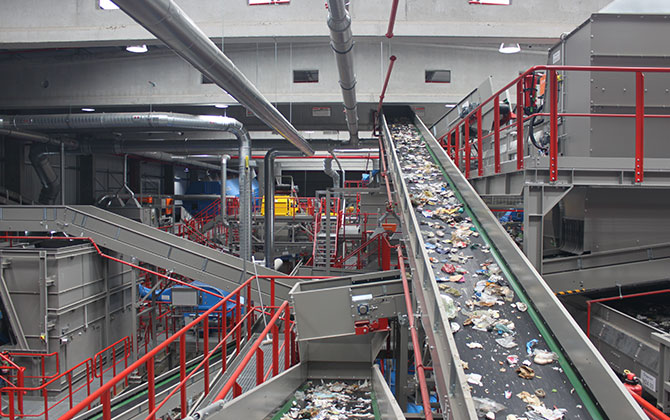Processing and Sorting of Lightweight Packaging and Plastics
There are many different types of plastics, which makes separating the individual fractions very complex. But the processing is worth it!
What Exactly are Lightweight Packaging and Plastics?
Basically, a distinction is made between beverage, reusable, transport and sales packaging. Everything made of plastic, tinplate or aluminium is specifically considered lightweigth packaging (LWP). Packaging made of composite materials is also counted as LWP.
There is a wide range of various types of plastics, which differ in their individual properties and are suitable for very specific purposes. Three main categories are distinguished:
- Thermosetting Polymer
As the name suggests, thermosets are solidified or hardened plastics. They are used, for example, as flooring, casings for electrical goods or kitchen utensils. Melamine, PUR and Polyester belong to this category. - Elastomers
Elasticity is the essential characteristic of elastomers, such as PUR or Elastane. They are found in upholstered furniture, flexible foam or shoe soles. - Thermoplastics
Thermoplastics are neither as hard as thermosets nor as elastic as elastomers. They are moulded into their shape under the influence of heat and can usually still be deformed or moved later. HDPE, LDPE, PP, PVC, PS, EPS, PA, Polyester (especially PET) and PUR or PU are typical thermoplastics. They are used for bottles, adhesive tapes, clothing, insulation materials and much more.
Polyurethane (PUR) is represented in all three categories, since – depending on the processing – it can have completely different properties.
What are Composites?
The classic example of packaging made of composite materials is the beverage carton: this is a cardboard carton with a plastic lamination and possibly an additional aluminium coating – in short: a full-surface composite of at least two materials.
It is not uncommon for packaging made of composite materials to be falsely advertised as a more sustainable or environmentally friendly alternative to plastic or synthetic materials (for example, because the paper used is made of 100% recycled waste paper, etc.). In fact, the separation of the recyclable materials is far more complex and costly. Because separation is often not economical or the capacities for the lengthy process are exhausted, the packaging is therefore only thermaly treated in many cases. "
Why Should Lightweight Packaging and Plastics be Recycled?
The quantities of packaging materials produced are enormous. In order to conserve resources and protect the environment, the Packaging Ordinance was therefore introduced in Germany as early as 2003. This ordinance established the Dual System in Germany. In the meantime, this ordinance has also become binding for other European countries within the framework of the European Union. Since then, companies must also assume responsibility for the proper disposal of the packaging they put into circulation. The disposal of LWP is therefore not only generally desirable, but also obligatory within the European Union.
Individual countries have also enacted additional legislation. Germany, for example, has further tightened the requirements through the Packaging Act 2019 and has since increased the mandatory recycling quotas once again.
Does the Amount of Different Types of Lightweight Packaging and Plastics Influence Recycling?
Basically, the purer the material fractions are at the end of the process, the higher their resale value and the greater their chances of being recycled. Only fractions with a particularly high degree of purity can actually be used again for the manufacture of new products and packaging. The remaining material usually goes to thermal treatment and is used as substitute fuel for energy production.
As already explained, there are now many different types of LWP and plastics, which makes separation by type extremely complex. Equally important for separation is not only the material, but also the colour. Black plastics and packaging in particular, for example, are difficult to reprocess together with other materials.

How Does the Processing of LWP Work?
Our sorting plants are customised solutions, always tailored to the operator's requirements.The aim is to recover pure recyclables with the lowest possible sorting losses. Largely automated processes with flexible material flows are implemented. We recommend using our well-proven bag openers or bale breakers at the beginning of the treatment process. They enable the generation of an even and loose material flow to the screens, sifters or separators. Only oversized fractions in the material should subsequently be shredded for further processing. This saves costs and reduces the fines content. It also prevents accumulators, batteries or pressure vessels from being shredded or crushed. This considerably reduces the risk of fire in the sorting plants."

Depending on the material, the properties of the individual fractions in the LWP throughput differ. Sorting into corresponding fractions can be done in various ways using diverse characteristics. For example, the different densities of the materials can be used to distinguish them using detection technology with X-ray transmission.With the help of NIR (near infrared spectroscopy), the degree of absorption of a defined light spectrum is measured and used to distinguish between materials. In both cases, the output is done by compressed air. These high-tech methods are very cost-intensive. In addition, it is absolutely necessary to separate all components in the material flow and, if possible, to separate them into 2D and 3D in advance. This is also the reason why ballistic separators or air classifiers are installed prior to this separation technology.
For the separation of fractions according to weight, shape and composition, BRT HARTNER offers Ballistic Separators in different dimensions.
The stationary air classifiers from Eggersmann are able to separate the light fraction with its lower specific weight from the heavy fraction in the material by means of air flow.
Air Belt Separator BBS
Our ballistic separators make use of the ballistic principle: the material falls onto inclined, rotating paddles. Due to their physical properties, the materials react differently. Dimensionally stable hollow bodies such as PET bottles and heavier materials move downwards on a short path into the 3D fraction. Flat and lighter materials such as foils, paper or textiles move upwards to the 2D discharge.
Ballistic Classifier BS:
For optimal results, it is often advisable to combine different process technologies into a precisely coordinated process chain. How exactly the sorting should be structured depends essentially on the desired number of separated fractions. In addition, certain types of lightweight packaging may also require the use of special machines. An example of this is our PET Perforator, which cuts into the bottles and hollow bodies for further processing so that the air can escape during subsequent pressing.
The individual fractions are allocated to separate material bunkers. Our intelligent bunker management system automatically organises the pressing processes of these now single-sort recyclable fractions into bales of uniform size and density. Overlaps and incomplete bales can thus be avoided.
References in Plant Engineering
Several Examples of Completed Projects!
Sorting Plant for Lightweight Packaging
Rostock
In the sorting plant, recyclable lightweight packaging gets filtered out and pressed for further treatment.
Contact
Contact us today! We are happy to support you in solving your waste problem!

Dr. Rolf Liebeneiner
Head of Sales
Biological Waste Treatment
Recycling Plants
Fon +49 5734 6690-0
r.liebeneiner(at)f-e.de

Gunnar Beyer
Head of Sales
Eggersmann Anlagenbau
Recycling Plants
Fon +49 5734 6690-227
g.beyer(at)f-e.de

Andre Berlage
Executive Manager
BRT HARTNER
Stationary Machines
Fon +49 5451 50773-31
Cell +49 160 90693161
a.berlage(at)f-e.de
